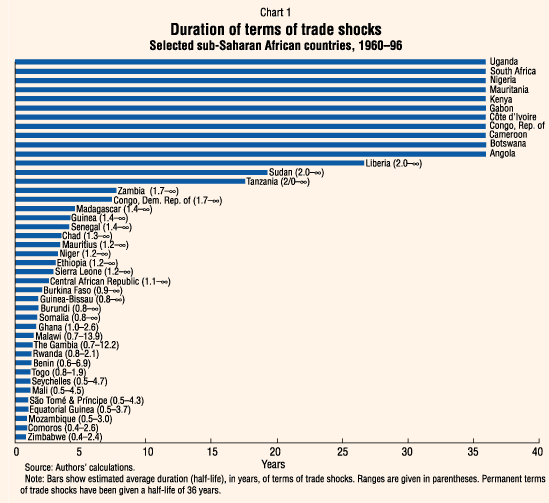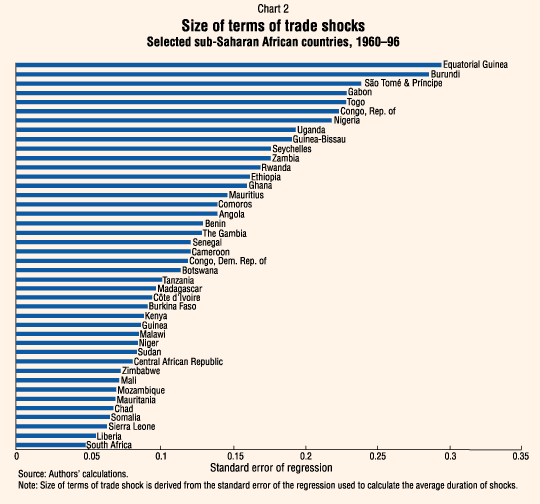 About F&D Subscribe Back Issues Write Us Copyright Information Use the free Adobe Acrobat Reader to view a pdf file of this article
|
The Duration of Terms of Trade Shocks in Sub-Saharan Africa Paul Cashin and Catherine Pattillo A characteristic common to the commodity-exporting developing countries of sub-Saharan Africa is that movement in their terms of trade is a key determinant of macroeconomic performance and has an important impact on real national incomes. However, there are marked differences across these countries in the typical duration of terms of trade shocks. The terms of trade is one of the most important relative prices in economics. The ratio of the prices of a country's exports to the prices of its imports defines the net barter terms of trade, which measures the number of units of imports that can be exchanged for a unit of exports. Changes in the terms of trade have an especially strong impact on the macroeconomic performance and incomes of commodity-exporting developing countries. For example, arabica coffee is the dominant export of Ethiopia. The slump in world coffee prices in 1986-87, caused largely by world production in excess of consumption, resulted in a 40 percent fall in Ethiopia's terms of trade. Because imports were about 15 percent of Ethiopia's national expenditure, this adverse movement in its terms of trade resulted in a decline of about 6 percent in Ethiopia's real income. Such terms-of-trade-induced shocks to real incomes in developing countries often necessitate a domestic policy response, but an important question for policymakers in framing an appropriate response is, how long lasting are typical shocks? The extent to which a country fundamentally adjusts to a shock—rather than attempting to smooth the economic effects by accessing international capital markets or changing domestic savings—should be determined by whether shocks to the terms of trade are typically short lived or long lasting.
|
|
Managing terms of trade shocks The exports of sub-Saharan African countries are dominated by primary commodities, while food items, oil, and manufactured goods are their major imports. In the policy debate on the causes of the steady deterioration in sub-Saharan Africa's export performance since the early 1970s, it has been argued that African governments have handled terms of trade shocks extremely badly and that an inability to cope with external shocks has contributed to Africa's debt problems and very low rate of economic growth. As a result of this mishandling, the gains obtained from positive terms of trade shocks have been small, while real losses from negative shocks have been large. For example, many African governments responded to commodity price booms in the late 1970s by sharply expanding public expenditure for hastily executed, import-intensive public investment programs that they either abandoned or financed with foreign borrowing when revenues subsequently fell because of steep declines in commodity prices. The difficulty of predicting the likely duration of commodity price shocks limits the ability of African policymakers to manage commodity booms and slumps. Given the problems in reliably forecasting commodity prices, some analysts have recommended that countries adopt simple policy rules, such as making fundamental adjustments in response to all price shocks except those that can be unambiguously identified as temporary. The same difficulties are involved in assessing the duration of shocks to the terms of trade. Is it possible to provide estimates of the typical duration and variability of terms of trade shocks that may allow for a deviation from this simple rule? Using annual World Bank data for 1960-96 on the net barter terms of trade indices of 42 sub-Saharan countries, we calculate the length of time it typically takes for the effects of terms of trade shocks to dissipate, estimate the variability of the duration of terms of trade shocks, and measure the typical size of terms of trade shocks (see box on page 29). We also examine the implications of these results for African policymakers. In forming projections of the likely duration of a particular terms of trade shock, policymakers can and should use episode-specific information—such as weather-related factors that are catalysts for large, short-lived movements in supply and, consequently, in world commodity prices. In addition, the typical duration of past terms of trade shocks, as calculated here, contains valuable information that can augment this episode-specific information. However, it should be kept in mind that once policymakers have formed a view of the likely duration of terms of trade shocks, their desired policy response may be constrained by financial market imperfections. For example, while many African countries presently do not have access to international capital markets to facilitate the smoothing of national consumption in response to external shocks, there is important scope for domestic policy responses, particularly saving decisions, in dampening the effects of such shocks. How long do shocks last? We find that, on average, the persistence of terms of trade shocks varies widely—for about half the sub-Saharan countries, such shocks are short lived (that is, half of the effect of the initial shock typically dissipates in less than four years) and for one-third of the countries such shocks are long lived (that is, permanent). The average duration, in years, of terms of trade shocks for each country is displayed (in descending order) in Chart 1.
 We find that the reversion of terms of trade to their mean (as measured by the shock's half-life) typically takes less than four years for 23 of the 42 countries. These countries have some scope to smooth national consumption by altering domestic savings in response to temporary terms of trade shocks. The potential benefits of informed savings responses are greatest for countries with shocks lasting less than two years—that is, for 16 of the 42 countries. The range of the duration of terms of trade shocks is also shown in Chart 1. For example, terms of trade shocks in Mozambique last from 0.5 to 3 years, whereas shocks in Tanzania last 2 years or more. Five percent of the time, shocks in Mozambique will last longer than 3 years, while 5 percent (or more) of the shocks to Tanzania will be permanent. This implies that, in the event of a terms of trade shock, it is likely to be much more important for Mozambique than for Tanzania to alter domestic saving to smooth national consumption, because the former has a much greater chance of experiencing short-lived shocks than the latter. Also, because the range of the duration of terms of trade shocks experienced by Tanzania is much wider than the range experienced by Mozambique, the variability of shocks is likely to be greater for Tanzania. In contrast, consider the 11 countries that typically experience very long-lived (permanent) terms of trade shocks. For these countries, half of the shocks will be finite and half will be permanent. Although these results do not rule out a change in domestic saving as a useful means of smoothing national consumption following terms of trade shocks, these countries are much likelier to experience long-lived shocks, which may make such switches between consumption and saving financially unsustainable. How large are shocks? While it is particularly important to ascertain the duration of shocks to the terms of trade, knowledge of the typical size of terms of trade shocks is also of great interest. Shocks that are typically small but long lived will have different implications for the setting of macroeconomic policies than large, long-lived shocks. In this connection, we can measure the size of shocks to the terms of trade, using the standard error of the regression analysis that calculates the duration of terms of trade shocks. As these errors are normally distributed, this implies that two-thirds of the time any change in the terms of trade is within one standard error of the initial level of the terms of trade, and one-third of the time any change is larger than one standard error. The values for the standard error of the regression for each country are displayed (in descending order) in Chart 2.
 As an example, for Côte d'Ivoire the standard error of the regression is 0.09, indicating that one-third of the time, the terms of trade of Côte d'Ivoire will be faced with the prospect of a change greater than 9 percent. Accordingly, in any given year, there is a one-in-six chance that the realized terms of trade of Côte d'Ivoire would fall (or rise) by 9 percent or more. The results in Chart 2 reveal that, unlike the typical duration of shocks to the terms of trade, the size of shocks is evenly distributed across African countries, ranging from the smallest shocks (South Africa) to the largest shocks (Equatorial Guinea). What determines the duration of shocks? Despite the common dependence of sub-Saharan economies on commodity exports, the typical duration of terms of trade shocks varies widely from country to country. What accounts for this? The results of an empirical analysis reveal that terms of trade shocks tend to last longer (with everything else held constant) for countries
Consequently, a country that is an intensive exporter of nonfuel commodities, is a relatively small-scale importer of petroleum products, and has as a major export a commodity subject to short-lived price shocks (such as The Gambia, which exports groundnuts) will typically experience short-lived shocks to its terms of trade. Alternatively, oil-exporting countries (such as Nigeria) will typically experience long-lived shocks to their terms of trade, because oil is subject to long-lived price shocks. Policy implications How might the estimates presented here of the duration and variability of terms of trade shocks be useful to African policymakers in reacting to a particular terms of trade shock? Currently, policymakers probably have little information on which to base an assessment of whether any given shock is likely to be short lived or long lived. Estimates of the average duration and variability of typical shocks can be used, together with episode-specific knowledge of world commodity-price movements, to form a judgment of the likely duration of a terms of trade shock. The ranges (confidence intervals) measuring the variability of shock durations are important here, because it is possible to estimate shock duration with some degree of precision for certain countries, whereas for other countries the range of shock durations is wide, indicating a broad range of possible outcomes.
The decision whether to borrow from abroad or to adjust to terms of trade shocks was important for African countries during the 1960s, 1970s, and early 1980s, but African countries have generally not had access to world capital markets since the debt crisis of the mid-1980s. Indeed, uncertainty concerning the typical longevity of terms of trade shocks may have contributed to overborrowing during this period, which is at the root of the current debt problems of many African countries. Countries with long-lived negative shocks that were mistakenly perceived as temporary may have been more likely to undertake unsustainable external borrowing. Similarly, countries with short-lived positive shocks that were mistakenly perceived as permanent may have also undertaken excessive external borrowing. This history illustrates that in deciding how to use measures of the typical duration of terms of trade shocks in attempting to improve on a rule that assumes all shocks are permanent, policymakers will need to weigh their options according to the consequences, as well as the likelihood, of being wrong. While the duration of a shock to a particular country's terms of trade should fall outside its measured range only 10 percent of the time, the potentially large economic costs of an actual shock falling outside this range will also influence a policymaker's assessment of the likely duration. In response to terms of trade shocks, African policymakers make important decisions that influence domestic saving rates, with the goal of smoothing the path of national consumption. For example, estimates of the expected duration of a positive temporary shock, however formed, are the basis for public and private decisions on the desirable rate of saving out of temporarily higher income. This is particularly important in the case of temporary positive shocks, because increased domestic saving during a temporary windfall can raise current and future output. The shorter the expected longevity of the shock, the higher should be the windfall saving rate. Particularly for the majority of countries with relatively short-lived shocks, measures of average shock duration and their associated variability can also be useful in informing domestic saving decisions.
This article is based on Paul Cashin and Catherine Pattillo, 2000, "Terms of Trade Shocks in Africa: Are They Short-Lived or Long-Lived?" IMF Working Paper 00/72 (Washington: International Monetary Fund). Suggestions for further reading:
|